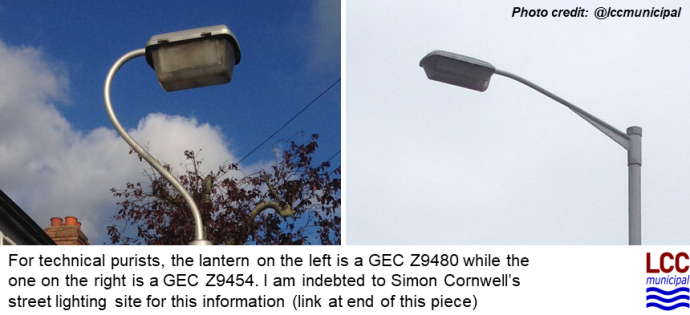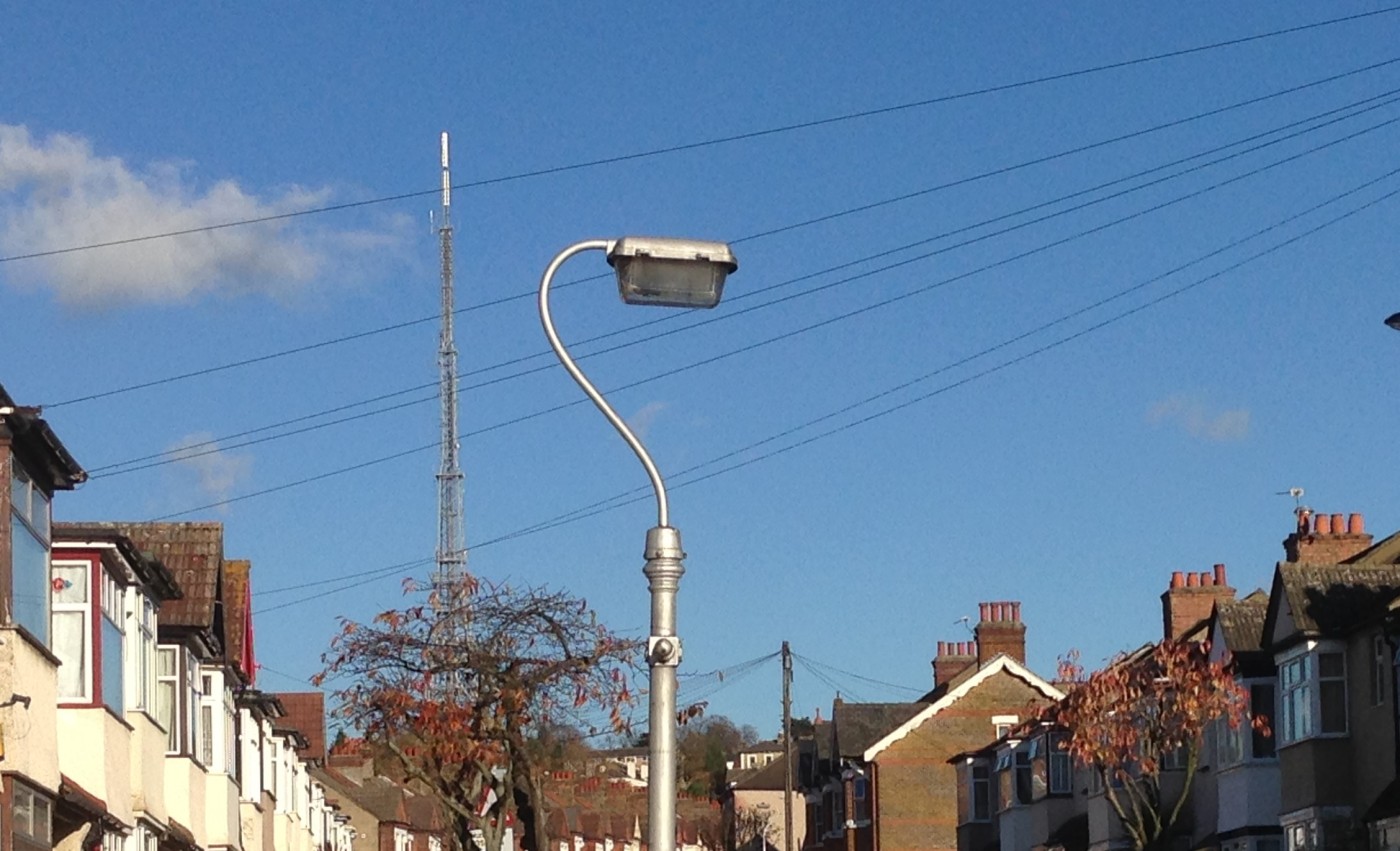This is a post about street lighting in Croydon. Well, no one else is going to write it.
Why the interest? I am fascinated with how the everyday and mundane often quietly disappears unnoticed and unremarked upon. Things which we have grown up with, that have always been minor characters in the background to our lives cease to be, without a trace remaining. The goal of this post is to leave a trace…
What has prompted this piece is the recent conclusion of a Private Finance Initiative (PFI) to replace the street lighting in the London Boroughs of Croydon and Lewisham. A five-year programme of replacement has swept across the two Boroughs – a fairly straightforward affair in Lewisham but an extremely complex undertaking in Croydon. And I find that complexity interesting because it tells us something about the history of local government in Croydon and the development of the town as a whole.
The majority of the now-removed Croydon street lighting dated from the late 1950s and early 1960s, with replacements in the subsequent 30 years replicating the established theme of silver lamp posts and the warm, familiar (but somewhat inefficient and now unfashionable) orange glow of sodium lanterns. The original installation coincided with Croydon’s great period of post-WW2 redevelopment, and, to my mind at least, the lamps were as much a part of the new “space age” Croydon as the tower blocks, underpasses and flyovers.
And now they are gone. Part of my 40+ year mind’s eye perception of Croydon has been removed and it is a little disorienting. Street lighting is a functional thing, there to guide us and keep us safe – there is no question that it is right to keep it current and effective. We shouldn’t subordinate our very real needs to nostalgia.

But I also think street lighting plays a (probably small) part in creating the identity of a place. It is ubiquitous in built up areas and, of course, at night time it defines the space we observe: what can be seen and what is in shadow.
There is a less immediately obvious way in which it talks to ideas of identity. Different boroughs made different purchasing decisions over the years and the wide range of now defunct British suppliers of posts and lanterns such as GEC, Revo, Eleco, Stanton and Concrete Utilities created much variety, now largely lost. Cross a borough boundary and the street lighting was one of the things that changed. Although uncommon now, lamp posts were often painted in Corporation colours – in Croydon’s case, silver (the colour of childhood spaceships) was entirely in keeping with the town’s 1950s futuristic vision.

So, until the PFI programme removed them, we were surrounded by infrastructure that was an authentic piece of the “New Croydon”. But the story goes back beyond the 1950s and 1960s, as beneath the surface of the streets, the lighting network owed its existence to an earlier time.
One of the main requirements of the recent PFI programme was to place the new street lighting on to UK Power Networks’ main electricity grid, in line with the majority of public lighting infrastructure in the UK. Croydon was unusual in that much of the street lighting was powered by its own network, which had its roots in the former County Borough of Croydon’s electricity generating might. Herein lay the complexity.
Up until 1965 and its absorption into Greater London, Croydon was a County Borough within Surrey. County Boroughs were imperious beasts which enjoyed far more clout and responsibility than other forms of local government such as municipal boroughs and urban/rural district councils. The original “Croydon A” power station on Purley Way was built by Croydon Corporation and opened in the late 1890s. One of its functions was to generate electricity for lighting the streets, and it is this early 1900s network, much amended and added to, that remained in operation across large parts of the Borough until very recently.

In fact, right up until its substantive decommissioning in 2016, the network – known as the CCN or CCS (Croydon Central Network or System) – was powered by an electricity substation on Purley Way, adjacent to the former power station site. Thus, the starting point for the whole network (which, in 2011, still powered 70% of the Borough’s street lights) remained unchanged even though the power station was long gone, its only remaining visual trace being the IKEA chimneys.
Like the dendritic pattern of ice fracturing across a frozen pond, the CCS had spread throughout the Borough by way of a complex system of branches and spurs. Its piecemeal development was poorly documented and therefore not well understood, which created significant difficulties for the recent PFI contractor, Skanska.
What was clear is that not all street lights were equal. Across the network were “feeder” lamp posts upon which other lights depended for their power supply. As the PFI programme progressed, it was common for stumps of lamp posts to remain with a “Caution – temporary CCS feeder” notice attached. Accidently take one of these out and whole streets could be plunged into darkness. Mapping the CCS, and identifying these feeder lights was at the heart of the complexity.

When undertaking its original replacement programme in the 1950s and early 1960s, Croydon – still an all-powerful County Borough at the time – was clearly able to work within the limitations of the CCS. This was not the case in 2011 when the PFI scheme commenced. The (by now) ancient CCS was unstable and unreliable and its decommissioning was the only option. But it meant the end of an all-pervasive, yet largely unknown, piece of infrastructure that had been central to the Borough’s operation for just over a century. A hidden history that will now recede into the past.

Writers such as John Grindrod, and artists such as Matt Bannister have worked tirelessly to reawaken our collective interest in Croydon and to see its beauty. The very existence of the Croydon Modernist Society and National Trust walking tours of the central business district demonstrate a raised awareness of what the town represents in the social history of post-WW2 London (and Britain for that matter). In writing this post, I am, of course, coming to the “Croydon reappraisal” quite late. I am going to make a claim, though, for the inclusion of the CCS and its now departed silver lamp posts within that reappraisal. It’s yet another thing which made Croydon a bit exceptional. After all, it’s not all about tower blocks, underpasses and flyovers…
Notes
Background on the PFI programme and the CCS was taken from a 2014 report into the PFI programme by the Croydon Council Streets & Environment Scrutiny Sub Committee.
Simon Cornwell’s street lighting site can be found here: http://www.simoncornwell.com/lighting/

